
This 6-minute video lesson looks at 2010 IIT JEE Paper 1 Problem 45 Circle Hyperbola Common Tangent.
- Subject:
- Math
- Material Type:
- Activity/Lab
- Provider:
- Khan Academy
- Provider Set:
- Khan Academy
- Author:
- Khan, Salman
- Date Added:
- 10/10/2018

This 6-minute video lesson looks at 2010 IIT JEE Paper 1 Problem 45 Circle Hyperbola Common Tangent.

This 11-minute video lesson continues to look at 2010 IIT JEE Paper 1 Problem 45 Circle Hyperbola Common Tangent.

This 9-minute video lesson continues to look at 2010 IIT JEE Paper 1 Problem 45 Circle Hyperbola Common Tangent.

This 11-minute video lesson continues to look at 2010 IIT JEE Paper 1 Problem 45 Circle Hyperbola Common Tangent.

This 12-minute video lesson concludes the look at 2010 IIT JEE Paper 1 Problem 45 Circle Hyperbola Common Tangent.

This 13-minute video lesson looks at 2010 IIT JEE Paper 1 Problem 46 Circle Hyperbola Intersection.

This 9-minute video lesson is about identifying conics.

This 6-minute video lesson looks at non-linear systems of equations.

This 7-minute video lesson concludes the look at non-linear systems of equations.

A brief refresher on the Cartesian plane includes how points are written in (x, y) format and oriented to the axes, and which directions are positive and negative. Then students learn about what it means for a relation to be a function and how to determine domain and range of a set of data points.

This task presents a real world application of finite geometric series. The context can lead into several interesting follow-up questions and projects. Many drugs only become effective after the amount in the body builds up to a certain level. This can be modeled very well with geometric series.
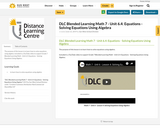
The purpose of this lesson is to learn how to solve equations using algebra.
Included is a YouTube video to support Grade 7 Blended Learning Math - Unit 6.4: Equations - Solving Equations Using Algebra.
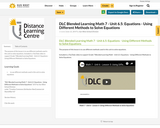
The purpose of this lesson is to use different methods used in this unit to solve equations.
Included is a YouTube video to support Grade 7 Blended Learning Math - Unit 6.5: Equations - Using Different Methods to Solve Equations.
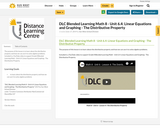
The purpose of this lesson is to learn about the distributive property and how we can use it to solve algebra problems.
Included is a YouTube video to support Grade 8 Blended Learning Math - Unit 6.4: Linear Equations and Graphing - The Distributive Property.
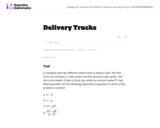
The primary purpose of this task is to illustrate certain aspects of the mathematics described in the A.SSE.1. The task has students look for structure in algebraic expressions related to a context, and asks them to relate that structure to the context. In particular, it is worth emphasizing that the task requires no algebraic manipulation from the students.
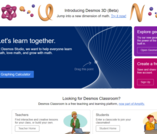
Desmos now has way more than just a graphing calculator (which is pretty great too!).
You can now access student or teacher accounts for free and find interactive lessons for online and classroom learning for Grade 6-12+ Math.
Topics include linear equations, 3D models, quadratic equation, exponential functions, problem solving, real world application, linear functions, etc.
Engaging activities include pizza maker, marble mini golf, scaling machines & much more!
Once you're comfortable, you can even make your own activities!

This task does not actually require that the student solve the system but that they recognize the pairs of linear equations in two variables that would be used to solve the system. This is an important step in the process of solving systems.

This purpose of this task is to help students see two different ways to look at percentages both as a decrease and an increase of an original amount. In addition, students have to turn a verbal description of several operations into mathematical symbols.

Students act as Mars exploratory rover engineers, designing, building and displaying their edible rovers to a design review. To begin, they evaluate rover equipment and material options to determine which parts might fit in their given NASA budget. With provided parts and material lists, teams analyze their design options and use their findings to design their rovers.

This task asks students to use inverse operations to solve the equations for the unknown variable, or for the designated variable if there is more than one. Two of the equations are of physical significance and are examples of Ohm's Law and Newton's Law of Universal Gravitation.